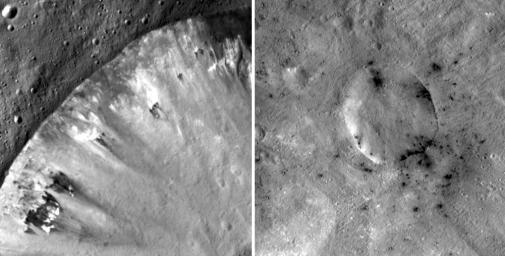
|
Dark Crater Rims
- Click the image above for a larger view
- Full-Res JPEG (1019 x 517) (91.9 kB)
- Full-Res TIFF (1019 x 517) (527.6 kB)
Caption:
These mosaic images from NASA's Dawn mission show how dark, carbon-rich materials tend to speckle the rims of smaller craters or their immediate surroundings on the giant asteroid Vesta. The image on the left is Numisia Crater and the image on the right is a shallow, unnamed crater in the Sextilia quadrangle.
The left-hand image was obtained by Dawn's framing camera during its low-altitude mapping orbit phase, about 130 miles (210) kilometers above the surface. The image on the right was obtained during Dawn's high-altitude mapping orbit, about 420 miles (680 kilometers) above the surface. The images have been photometrically corrected. North is up.
Background Info:
The Dawn mission to Vesta and Ceres is managed by NASA's Jet Propulsion Laboratory, a division of the California Institute of Technology in Pasadena, for NASA's Science Mission Directorate, Washington. UCLA is responsible for overall Dawn mission science. The Dawn framing cameras were developed and built under the leadership of the Max Planck Institute for Solar System Research, Katlenburg-Lindau, Germany, with significant contributions by DLR German Aerospace Center, Institute of Planetary Research, Berlin, and in coordination with the Institute of Computer and Communication Network Engineering, Braunschweig. The framing camera project is funded by the Max Planck Society, DLR and NASA/JPL.
More information about Dawn is online at http://www.nasa.gov/dawn and http://dawn.jpl.nasa.gov .
Cataloging Keywords:
| Name | Value | Additional Values |
|---|---|---|
| Target | 4 Vesta | |
| System | Main Belt | |
| Target Type | Asteroid | |
| Mission | Dawn | |
| Instrument Host | Dawn | |
| Host Type | Orbiter | |
| Instrument | Framing Camera (FC) | |
| Detector | ||
| Extra Keywords | Crater, Grayscale | |
| Acquisition Date | ||
| Release Date | 2013-01-03 | |
| Date in Caption | ||
| Image Credit | NASA/JPL-Caltech/UCLA/MPS/DLR/IDA | |
| Source | photojournal.jpl.nasa.gov/catalog/PIA16630 | |
| Identifier | PIA16630 | |
